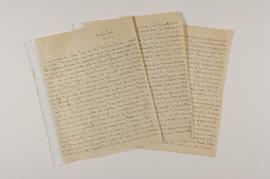A collection of 13 letters purchased at auction in 2008, written by Reginald Farrer and most likely sent to the British Diplomat Ernest Frederick Gye C.M.G., though Farrer tends to refer to him as his “Poison”, “Viper” or “Venom”.
Gye's mother was the singer Dame Emma Albani and his father was Ernest Gye, the lessee of Covent Garden theatre. Gye entered the Foreign Office in 1903, became Second Secretary in 1908 and Councillor in 1924. He served for some years in Tehran in the earlier part of his career (and where he was when these letters were written) before being appointed Minister and Consul General in Tangier in 1933. Three years later he was made Minister Plenipotentiary in Venezuela, retiring in 1939.
The 13 letters were written in Upper Burma (now Myanmar), mainly from Hpimaw and Nyitadi, and date between May 1919 and September 1920, the last being written only five weeks before his death. The letters are liberally peppered with nicknames and gossip, and the identity of everyone mentioned may never be known; for example, his 1919 travelling companion, fellow plant collector Euan Cox, is often referred to by the name “Jumps”. In amongst intimate information and personal references are descriptions of the country, people met and plants collected.
A collection of 21 letters donated to the RBGE Archives in 2017, written by Reginald Farrer and sent to Lady Celia Brunel Noble.
Zonder titelSet of letters and notes between William Wright Smith, A. Grove, H.D. McLaren, F.C. Puddle, and William Edgar Evans and including references to Messels of Nymans, all relating to Frank Kingdon Ward's Lilium wardii no. 6034.
Zonder titel- 3 letters with their envelopes written to Thomas Douglas Grieve relating to his career - 05 January 1928, William Wright Smith to Thomas Douglas Grieve offering him a place on the probationer course; 15 March 1937, Lord Alness to Thomas Douglas Grieve offering best wishes on his post in Jamaica; 03 April 1937, John Macqueen Cowan to Thomas Douglas Grieve congratulating him on his post in Kingston, Jamaica.
- Probationer Gardener Papers- 1 lecture synopsis and 7 exam papers sat by Grieve during his probationer gardener career at RBGE - lecture synopsis, 1929-1930; exam papers: Forest Botany, 03 April 1928; Botanical Nomenclature, 25 March 1929; Book-Keeping, 17 December 1929; British Timbers, 31 March 1930; Plant Propagation, 22 July 1930; Forest Botany (2), 30 March 1931; Plant Pathology, 13 July 1931;
- copy of Dobbie's Horticultural Handbook, 1898 that mentions James Grieve (pp15, 16 and 25 (and John Downie on page 11)) - this book is now in the library collection.
REC/2: Roland Edgar Cooper – Correspondence and Papers, 1913-1961
REC/2/1: Correspondence and Papers – Isaac Bayley Balfour, 1913-1919
Folder of papers presumably retained by Isaac Bayley Balfour. Includes correspondence; Notes on Environment of Plants of Seed Numbers, Gathered in Bhutan, 1914, by R.E. Cooper; List of Seeds sent by Cooper, via A.K. Bulley, Sikkim and Tibet, 1913.
REC/2/2: Correspondence and Papers – British Museum, 1930,1952
Folder of correspondence between William Wright Smith and Brian Burtt of the Royal Botanic Garden Edinburgh and George Taylor of the British Museum (Natural History) regarding the sending of Cooper's specimens to the British Museum for determinations - this includes plant lists. There are also two lists with duplicates: 1-2. "Determination of Indian Plants collected by RE Cooper Esq 1914- for British Museum, 1st list, Edin." and 3-4. "Identification of Plants for the British Museum. Coll. RE Cooper, 2nd list, Jan. 1930"
REC/2/3: Correspondence and Papers – Assorted Documents, 1916-1961
Assorted documents relating to R.E. Cooper, provenance unknown and arranged by date where known.
• Extract from letter dated 18th September 1916 from Sir Isaac Bayley Balfour to Roland Edgar Cooper [in Cooper's hand? written out on Cooper's lecture notes?] Original copy in Isaac Bayley Balfour correspondence folder: GB 235 REC/2/1/19
• Typescript of two letters, the first from William Wright Smith to Isaac Bayley Balfour, 27/05/1921; the second from R.E. Cooper to William Wright Smith, 04/06/1921 from the Botanic Garden in Maymo, Burma.
• [William Wright Smith?] to R.E. Cooper, 28/06/1929 regarding identification of plants.
• R.E. Cooper's collecting numbers - brief summary by Cooper with two copies, 03/03/1931.
• Modern list outlining Cooper's ethnographic donations to the National Museums of Scotland in 1931-32.
• Partial copy of John Anthony's "Remarkable Alpine Lobelia from Bhutan" published in the Notes from the Royal Botanic Garden Edinburgh, July 1936.
• List of determinations of Bhutan grasses sent on loan to Dr. Bor of the Royal Botanic Gardens, Kew, 01/05/1948. "R.E. Cooper's collection"
• letter: R.E. Cooper to Harold Roy Fletcher, 10/10/1961
• Three pages of Collection Numbers entitled "Cooper's Bhutan Collection" - undated.
• "Cooper's Saxifragas, etc." arranged according to Engler et Irmscher Monograph - undated.
•1 box of miscellaneous papers and glass plate negatives regarding Bhutan, 1949, also 3 reels of film, now converted to DVD:
- Diary Materials 1, 1949
- Diary Materials 2, 1949
- Transcript of Diaries by David Shepherd - not for reproduction
- letters, mainly from George and Betty Sherriff, Frank Ludlow and David Humphreys
- Christmas cards, mainly from George and Betty Sherriff and Frank Ludlow, usually illustrated with photographs or Margaret Stones illustrations
- small box of 12 glass lantern transparencies, mostly plant portraits - tape around slides very brittle; annotations in danger of being lost, so handle with extreme care
- cine film x 3 - converted to dvd
- 'misc' folder; contains LSH seed lists 1949 documents and key to the cine film
- newspaper cuttings - mostly relating to Bhutan
- 'misc' publications - mostly relating to Bhutan, some by Frank Ludlow
A collection of Reginald Farrer's writing, donated to the RBGE Archives in 2005 by his family, comprising mainly letters and plays.
Zonder titel